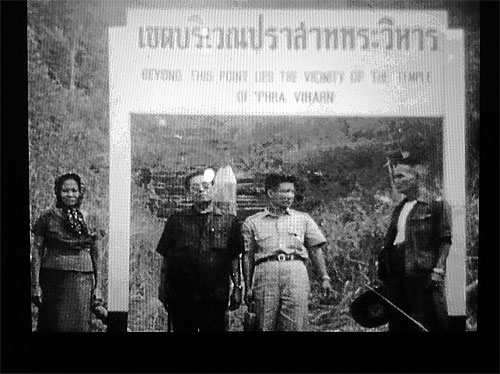Published: 31 Jan 2013
The ongoing military exercises near the Thai-Cambodian
borders give the impression that tensions over the long-standing Preah Vihear
temple (known in Thai as Wat Khao Phra Viharn) dispute are escalating.
A file photo taken in 1962 shows a group of senior
Thai officials posing in front of a sign stating ‘Beyond this point lies the
vicinity of Wat Khao Phra Viharn’, next to the temple’s stairs.
This is because this year's drills, while being an
annual affair, are noticeably comprehensive involving troops from several
units, from infantry, cavalry, artillery and special task forces as well as
those from an engineer tank battalion.
No less important are the drill sites, covering the
border areas from Surin, Ubon Ratchathani and Si Sa Ket _ which are under the
jurisdiction of the Suranaree Task Force _ and the stretch behind the disputed
4.6 sq km area around the Preah Vihear ruins.
At the same time, the navy's Combined Arms Live Fire
Exercise (Calfex), which is to take place tomorrow, will be presided over by
senior figures like Supreme Commander Tanasak Patimapragorn and navy commander
Admiral Surasak Runroengrom.
There are also reports of Cambodian military exercises
on the other side of the border, next to the temple.
Some have interpreted the military drills, which are
to be completed in March, as a signal to the International Court of Justice
(ICJ), which will deliver a ruling that will affect the people of both Cambodia
and Thailand.
Apart from the show of military prowess, it happens
that army chief Prayuth Chan-ocha has adopted a more aggressive tone, with his
"ready-to- fight" message when asked what the Thai army will do if the
ICJ gives an unfavourable ruling leading to the loss of territory.
"We, the soldiers, are ready when the time comes.
But that's entirely up to the government whether we will withdraw the troops,
or if we will opt for war," Gen Prayuth said.
We also need to ask the people if they are ready to
have our soldiers fight and accept the consequences _ and losses _ that will
follow. If they are ready, so are the soldiers."
This contradicts his earlier softer position which was
branded by Sondhi Limthongkul, a core leader of People's Alliance for Democracy
(PAD), as "unpatriotic" amid suspicions of a trade-off between the
disputed land and offshore oil exploration rights.
"I am not aggressive. Nor am I a warmonger. Use
of force is the last resort that must come after the rule of law, and
negotiations. Every dispute ends on the negotiating table," Gen Prayuth
said. "But if there is no other choice. We have to use force to protect
our land, our sovereignty and national dignity."
At the same time, the army has tried to win
international praise by complying with the ICJ's injunction to pave the way for
a demilitarised zone and cooperating with Cambodia on landmine clearance in
border areas covering 7.3 sq km, including the disputed zone.
After two meetings _ the second being held in Siem
Reap province until today between Thailand Mine Action Centre (TMAC), under Lt
Gen Sihanart Wongsaroj, and its counterpart CMAC _ joint demining operations
are expected to take place next month or in March, before both countries attend
the ICJ's oral hearings in the Hague from April 15-19.
"At the very least, the army wants to convince
the ICJ that Thailand and Cambodia can solve problems at the bilateral level
without intervention by a third country. In other words, the ICJ should let the
neighbours handle their own problem," a military source said.
If the ICJ delivers a favourable ruling, either
finding it has no jurisdiction in the dispute or sticking to the 1962 verdict _
that Cambodia owns the temple and the 20m x 100m area surrounding the temple _
which was endorsed by the Sarit Thanarat government, both sides could end their
conflict and move on to joint tourism and trade development in the disputed
area.
Army sources say Thailand is preparing to show the ICJ
old pictures as evidence. Some show then-Prince Norodom Sihanouk popping
champagne to celebrate the 1962 verdict near a now-removed fence that was set
up by the Thai government in accordance with the court verdict. The pictures
are intended to show that Cambodia then accepted Thailand's ownership of the
land beyond the fence.
But the scenario will be different if the ICJ favours
Cambodia's petition by handing over more land claimed by Thailand, including
the Sa Tao and Sathup Khu areas, as part of the temple to Cambodia. Or worse,
it could hand the entire 4.6 sq km disputed area to Cambodia in accordance with
the controversial 1:200000 map drawn by France.
his is the reason Defence Minister ACM Sukumpol
Suwanatat and his Cambodian counterpart Tea Banh have been in contact a lot
more often to ensure that soldiers on both sides of the border stay calm, while
the military closely monitors the situation.
"We are to cooperate more under the Asean
Economic Community framework, there is no reason to use force," said the
minister. "If you ask if I have any concerns [about the border dispute], I
do. But I don't want to talk too much. I don't want to be pessimistic. We
should look on the bright side _ that the court is fair and there will be no
war."
Wassana Nanuam is a senior news reporter covering
military affairs for the Bangkok Post.


No comments:
Post a Comment